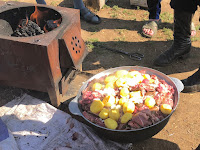Mongolia, known as the birthplace of Genghis Khan, is a unique country. With many of its citizens living nomadically, more livestock than humans and a national sport with the most provocative costuming one may ever see in a sporting arena, it's difficult to compare Mongolia to any other nation. Here are a few random facts about the land of the eternal blue sky!
1. Blue Skies
Mongolia really is known as the "Land of the Eternal Blue Sky"! On average there are 250 sunny days in Mongolia! Don't be fooled - when it comes to the weather, Mongolia is a land of extremes. It's capital city, Ulaanbaatar, is the coldest capital in the world with an average low of -20 ℉, while in the summer months it can reach above 100 ℉ in the Gobi desert.
2. Population
Mongolia is one of the most sparsely populated countries in the world, with just over 3 million people and 4 persons per square mile. Historically, most Mongolians were nomadic herders. With the advent of the 20th century, people's lifestyles have changed quite a bit, but a whopping 30% of the population still live as nomadic herders. Ulaanbaatar, the capital city, contains around 45% of the country's population.
3. Horses
Horses are a major component in Mongolian culture and history. Currently, there are about 3.6 million horses, compared to only 3 million people. Mongolians don't corral horses, and seeing small herds roaming through the outskirts of towns and cities is very common. Horse racing is also one of the most popular sports, and every year during the summer Naadam festival, races across the wide open lands are held for small children and adults alike.
4. Wrestling
One of Mongolia's "three manly sports" is wrestling. Wrestling actually has a long history in Mongolia, much older than Genghis Khan. Mongolian wrestling includes a ritualistic "eagle dance" where the wrestlers present themselves before the match by spreading their arms wide, slowly spinning and hopping towards the ring. After the match, the winner often performs this dance again. The most noticeable aspect of Mongolian wrestling, however, are the colorful costumes! Like all wrestling costumes, the Mongolians' outfit stresses mobility and function.
5. Food
More than half of the average Mongolian's diet consists of animal products; minimally seasoned meat is consumed at every meal with few exceptions, and dairy products such as milk, yogurt and dried milk curds are eaten most days. Most vegetables are of the root variety, though pickled cucumbers and jarred salads are also popular additions at meals, and larger supermarkets carry a variety of seasonal fruits and vegetables. Sweets are very popular, and upon entering someone's home a bowl of candy is normally offered, often along with savory milk-tea. One of Mongolians most famous dishes is khorkhog; fresh meat, potatoes, carrots and onions are either sewn inside the butchered animal's skin and slow roasted, or placed in a metal cooking pot over a fire. The resulting meal is eaten using the hands, and sides such as kimchi, pickles and salads or also common.
6. Nomads
Traditionally a culture centered on herding, more than 30% of Mongolians today live as nomadic herders. The livestock raised is both used for subsistence and economic purposes. Mongolians herd sheep, goats, cattle and horses; camels are raised in the southern provinces. Up north the occasional yak can be spotted, as well. The smallest ethnicity in Mongolia, the Tsaatan (also called the Dukha) are famous for raising reindeer in the northernmost province of Khuvsgul. Mongolian nomads typically move four times a year, though during the school year, children from nomadic families typically board in school dormitories.






No comments:
Post a Comment